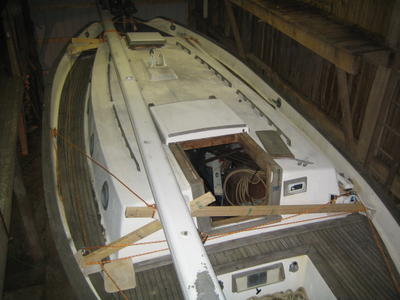I always expected to build an airplane, and when I was on the verge of sending off a deposit check for an RV-8 kit, my wife, Barbara, finally put her foot down and declared that she would never fly in it. I was more than a little taken aback, since we had talked about this for years and I already had the engine in the garage, but it was obvious that she had some deep-seated fears of flying in small aircraft. We had to arrive at a compromise, since I knew that I had to have a long-term project to replace work once I retired.
Barb and I had always enjoyed sailing, having owned a small 19-foot daysailer when we were stationed in Bermuda with the Navy, and I've had the opportunity to crew on a Luders 44 yawl, not to mention sea duty in the Navy aboard a guided missile cruiser (USS Harry E. Yarnell, CG17). A cruising sailboat seemed to be the natural compromise!
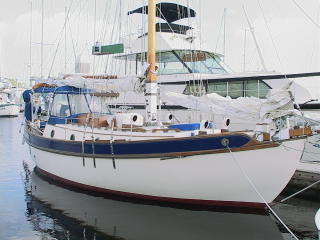
Little did Barb know that I would not waste time finding the right boat project. I had always admired the Westsail 32, a sturdy double-ended cutter based on the designs of Colin Archer in 1898. His North Sea life boats and pilot boat designs are graceful and seaworthy craft that have survived the worst the sea can throw at them. I have seen them in the middle of the Atlantic, and in ports as widespread as Taormina, Sicily, to San Diego, CA, and had always admired the lines.
As luck would have it, a Westsail 32 popped up on eBay and with Barb's apprehensive approval I decided to bid on it, based solely on two photos and a phone conversation with the seller. The boat was sitting in a farmyard 280 miles away, 75 miles north of Flint, MI, where it had been languishing for over ten years, slowly weathering and collecting dust.
For better or for worse, I won the auction on September 4th, (at a bargain price) and the next step was to inspect it and make plans to have it moved closer to us for a total make-over. A co-worker of mine has an unused barn with a 44 foot by 14 foot tractor bay that makes a good boathouse, and the hayloft (after it was cleared of old hay) is at nearly the deck-level of the boat, offering ample space for workbench, storage, sail loft and engine shop. As it turned out, he was more than willing to loan the barn in return for a crew berth.
I made the trip to Michigan the weekend of September 10th and shanghaied my cousin's husband, Jeff, into making the trek to Rhodes, MI, to check it out. I have to say that it was an odd sight to see the boat sitting 100 yards off the back-country road, more than 50 miles from the nearest big water. I was filled with excitement and apprehension as we approached the boat, but it was in as good a condition as I could have hoped for.

The exterior was weathered, but the teak decks and cap rail were good enough to be refinished, the hull was undamaged (it looked as though the owner had repaired some osmotic blisters of the underwater fiberglass), and everything seemed to be on-site. The sad part was that it looked as though he had completed only enough of the interior to be habitable, and a total make-over would be in order.
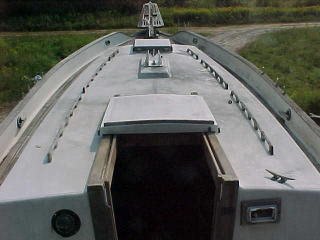
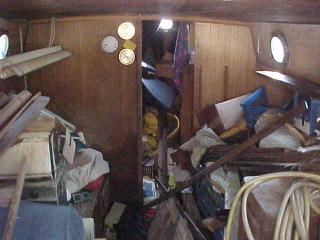
Over the years the cabin became a repository for everything and anything boat-related, and it looked as though a giant had shaken the boat, scattering everthing helter-skelter.
From the hull number (WSSK02961074) I learned that the boat was one of the 400-odd hulls that was sold as a kit (as opposed to the 700 others that were factory finished) to Fred Nelson, of Dearborn, Michigan. Laid up in October of 1974, the boat was Fred's pre-retirement project and he ultimately sailed it out of the Great Lakes, through the Erie Canal, down the Hudson River, and down the East Coast. Sadly, Wilmington, NC, was as far as he got. The details from his daughter, who was the executor of the estate, were sketchy. The family lived on the boat for over nine years, up and down the East Coast, but the charts of the South Seas that I found in the cabin were never used (interestingly, most date from WWII). In 1991 Fred decided to move back to Michigan, closer to his wife's hometown, and he paid to have the boat transported overland and put "on the hard" in a clearing at the front of his property.
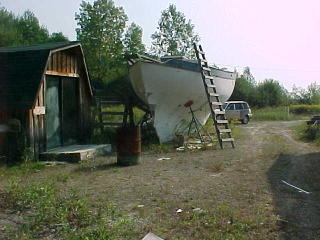
To my dismay, the boat was sitting on keel blocks and stands, not a proper cradle that would make transporting easy. I would have to have a mobile crane lift the boat onto a new cradle before I could have a hydraulic transporter pick up the cradle and boat and haul it to the barn in Warren, IN. Sounds pretty easy and straightforward, right? Not when "Murphy" is alive and well!
Before we could have the boat moved we had to (1) clear the barn of 80+ years of dirt and hay, demolish two 14x10x8 foot grain cribs over each end of the tractor bay (they were 12 feet in the air, made of native oak, but thankfully empty), (2) run electrical wiring for shoplights over the boat bay and workbench areas, (3) run outlets to both the bench and bay area, and (4) locate about a dozen oak blocks to set the boat cradle on. Then I had to (5) find and schedule a marine transporter, (6) a crane service, and (7) have a the cradle built to order.
You would think that oak blocks would be easy to find, but guess again! Normal lumber yards don't carry anything larger than 4x4 in oak, and I needed 6x6 to give clearance for the lifting bars of the hydraulic trailer. All of the wood I found was pressure treated fir or pine. I had to find a sawmill that would be willing to cut a 12 foot piece of 6x6, then I had to sweet talk them into cutting it into 12 inch lengths for me.
The cradle was another problem. With the onset of winter, all the boatyards in the Great Lakes region were busy hauling boats and all the cradles were in use, so I had to have one custom built. After several emails and calls I found a boatyard in Muskegon, MI, (Torreson's Marine) that would not only build the cradle, but would actually do it for about 60% of what the other cradle builders would do it. NauticMarine Transporters, whom I had contracted to make the move, had experience with Torreson's and they luckily had a Westsail 32 cradle in their yard that they could copy. All it takes is money and some hard work!
Finally, after a lot of sweat at the barn and numerous phone calls, everything seemed to be falling into place. Torreson's finished the cradle in record time (six days) and the transporter would be available on Tuesday, October 4th. As luck would have it, the crane from Dobson's in Bay City was obligated for the entire week of October 3rd, so I had to scramble to find an alternative. McNally's in Saginaw, MI, a bit further (naturally, since cranes charge by the hour, portal to portal) but with more capacity and experience lifting boats, was available.
Everything is in place for October 4th, and God willing we will have the boat safely ensconced in it's new temporary home by Tuesday night!
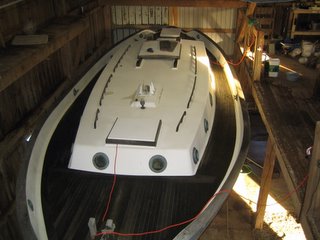
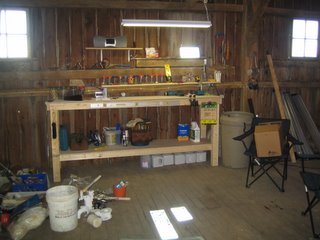 Barb gave me a hand finishing off the workbench and I tested my XM radio and found I got pretty good reception in the barn so now I can have music and keep up with news as I work. (Maybe I need a cot in the loft too, so I can take a quick power nap when I get tired!)
Barb gave me a hand finishing off the workbench and I tested my XM radio and found I got pretty good reception in the barn so now I can have music and keep up with news as I work. (Maybe I need a cot in the loft too, so I can take a quick power nap when I get tired!)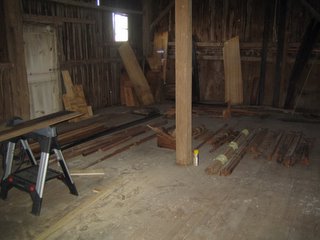 condition and will be put to good use. Our next task is painting the interior of cabinets, pulling the old head (marine toilet) and installing the new electrical wiring. If we can get the electrical done by Christmas we'll be well on our way.
condition and will be put to good use. Our next task is painting the interior of cabinets, pulling the old head (marine toilet) and installing the new electrical wiring. If we can get the electrical done by Christmas we'll be well on our way.

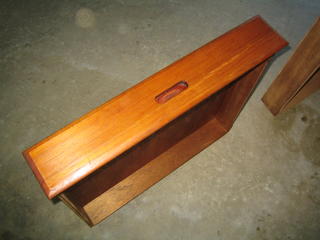




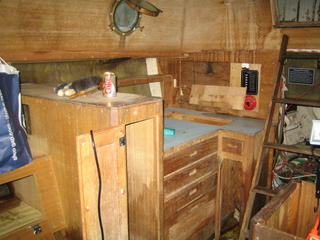


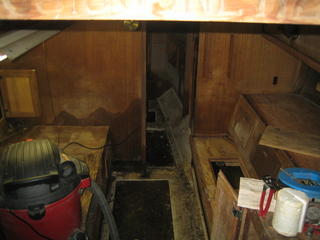
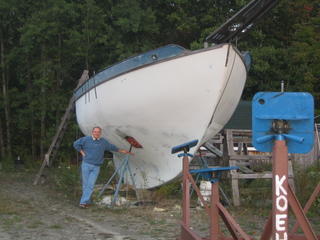
 I couldn't resist a moment of dreaming of sea-spray! I just hope the ghosts of the Titanic aren't watching me! I would have moved out onto the bowsprit platform, but it's about twelve feet to the ground and I don't like heights, plus without a more thorough inspection, I didn't trust a wooden platform that's been in the weather for ten years - even if it is teak.
I couldn't resist a moment of dreaming of sea-spray! I just hope the ghosts of the Titanic aren't watching me! I would have moved out onto the bowsprit platform, but it's about twelve feet to the ground and I don't like heights, plus without a more thorough inspection, I didn't trust a wooden platform that's been in the weather for ten years - even if it is teak.


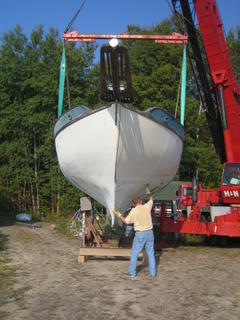





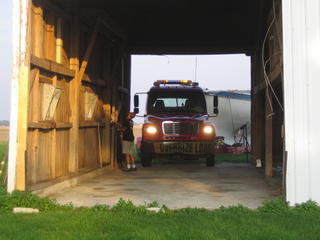


 As you can see from the front catwalk, the boat totally fills the tractor bay with just enough room at the sides to work on the hull. We can use the catwalks above each end of the tractor bay to get onto the boat, as well as a means of rigging tackle to lift objects (can you say "new diesel engine"?) into the boat. It's amazing how having the bulk of the boat in the barn makes you feel more comfortable walking on the catwalks!
As you can see from the front catwalk, the boat totally fills the tractor bay with just enough room at the sides to work on the hull. We can use the catwalks above each end of the tractor bay to get onto the boat, as well as a means of rigging tackle to lift objects (can you say "new diesel engine"?) into the boat. It's amazing how having the bulk of the boat in the barn makes you feel more comfortable walking on the catwalks!
